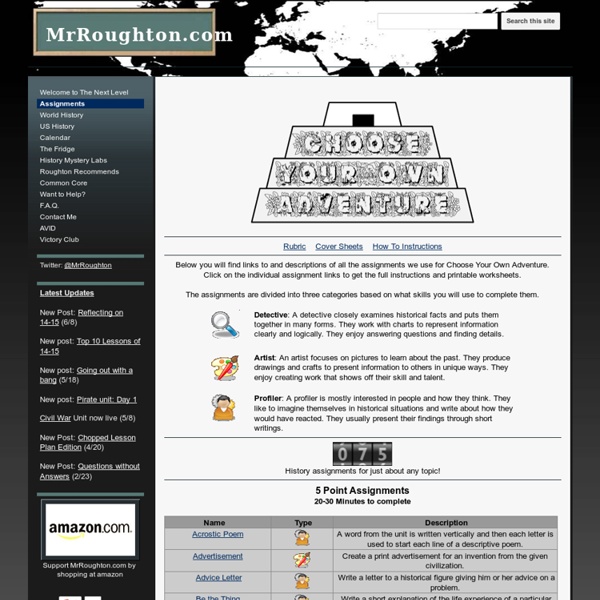Assignments - MrRoughton.com
Rubric Cover Sheets How To Instructions Below you will find links to and descriptions of all the assignments we use for Choose Your Own Adventure. Click on the individual assignment links to get the full instructions and printable worksheets. The assignments are divided into three categories based on what skills you will use to complete them. History assignments for just about any topic! 5 Point Assignments20-30 Minutes to complete 10 Point Assignments45 minutes to complete 20 Point Assignments90 minutes to complete40 Point AssignmentsAll 40 point assignments require significant work outside of class and take up to 4 hours to complete.
Classroom Architect
Cell Size and Scale
Some cells are visible to the unaided eye The smallest objects that the unaided human eye can see are about 0.1 mm long. That means that under the right conditions, you might be able to see an ameoba proteus, a human egg, and a paramecium without using magnification. A magnifying glass can help you to see them more clearly, but they will still look tiny. Smaller cells are easily visible under a light microscope. To see anything smaller than 500 nm, you will need an electron microscope. Adenine The label on the nucleotide is not quite accurate. How can an X chromosome be nearly as big as the head of the sperm cell? No, this isn't a mistake. The X chromosome is shown here in a condensed state, as it would appear in a cell that's going through mitosis. A chromosome is made up of genetic material (one long piece of DNA) wrapped around structural support proteins (histones). Carbon The size of the carbon atom is based on its van der Waals radius.
EducationalMiniMovies.com
The Differentiator
Try Respondo! → ← Back to Byrdseed.com The Differentiator The Differentiator is based on Bloom's Taxonomy, Kaplan and Gould's Depth and Complexity, and David Chung's product menu. Try It In: French Dutch • Tweet It • Like Byrdseed • Pin It Students will judge the ethics of the [click to edit] using a textbook and create an essay in groups of three. Revised Bloom's Taxonomy adapted from "A Taxonomy for Learning,Teaching, and Assessing: A Revision of Bloom's Taxonomy of Educational Objectives" by Anderson and Krathwohl Depth and Complexity adapted from The Flip Book by Sandra N. Depth Big Idea Unanswered Questions Ethics Patterns Rules Language of the Discipline Essential Details Trends Complexity Multiple Points Of View Change Over Time Across the Disciplines Imperatives Origin Convergence Parallels Paradox Contribution Key Words Consequences Motivations Implications Significance Adapted from David Chung and The Flip Book, Too by Sandra N. Group Size One Two Three Four
Rethinking the Writing Process with the iPad – Karen Janowski
Karen Janowski Twitter Profile On the second day of the conference, the first talk I attended was “Rethinking the Writing Process with the iPad” with Karen Janowski. I am especially eager for this topic as using the iPad as a word-processor is a common way that it is applied and often meets with ergonomic frustration. I know that as a touch typist, I can write well over 90 words a minute. The iPad cuts that down to at least half. She started by pointing out the flexibility of the iPad which means that these tools are not limited to older children – that we can apply various techniques and processes to students of all ages using the same tool. Students of all ages and skill levels often struggle with good writing. What skills are required for successful written expression? Is what we’re doing working? Most educators can say that what they do works for most students, but definitely not all. Word processing alone has had only a moderate effect on improving student writing (about 10%). Drafting
Web Search Strategies
The Web may seem like a vast ocean when it comes to finding something you need. Thankfully, search engines can help turn oceans of information into small pools that make finding information easier. Before we dive in, let’s talk a bit about how search works on the Web. Search engines go out and try to account for every word on every webpage. All this information is then organized for easy reference. When you search for a word, the search engine finds all the pages where the word appears, and displays them in the search results. The problem is that there are often too many results. Say you’re looking for a specific kind of fish, and these represent all the websites on the Web. Try to imagine the exact fish and describe it in the search box. But to be a smart searcher, you should know some basic shortcuts. Here’s another shortcut.
Free Visual Dictionary & Thesaurus | Online Dictionary | Associated Words | Synonyms Dictionary at SnappyWords.com
Transparent Curriculum
Computer Lab Favorites
Sign in -or- Register Computer Lab Favorites Site Map Use these interactive, self-contained activities to introduce a topic or enliven your lab time. PRIVACY POLICY · Terms of Use · TM ® & © 2016 Scholastic Inc. All Rights Reserved.
Related:
Related:



